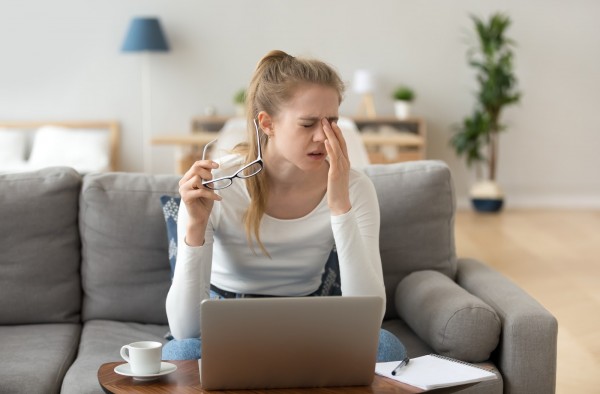There are several treatments for dry eye disease. Perhaps the easiest way to treat dry eye disease is with eye drops.
While eye drops might be the easiest to use, there are many different types and they help in different ways. Looking at all the available products might be confusing, but we’re here to help. Read on and discover the differences between them.
If you still aren’t sure about the best eye drops for your dry eye, make an appointment with your optometrist to discuss the options.
What Is Dry Eye?
If you have dry eye disease, there’s a good chance one of two main problems are occurring — either you aren’t producing enough tears or your tears are poor quality. No matter which type of dry eye you have, it’s uncomfortable.
The treatments for each type might be slightly different, depending on your particular circumstance and not all treatment involves eye drops. There are a variety of treatments available for dry eye, including technology like the Eye-Light, which we’ll talk more about later.
First, let’s look at both types of dry eye.
Not Enough Tears
If your eyes don’t make enough tears, or the tears they make dry up too quickly, chronic dry eyes can occur. Lifestyle and environmental factors play a role in how many tears your eyes produce and the level of evaporation.
Poor-Quality Tears
There are 3 main components that make up tears. Oil, water, and mucus all play a role in keeping your eyes lubricated. Without enough oil, water dries up too quickly and leads to dryness. If the mucus layer is out of balance, the tears might not spread properly over the eye.
What Causes Dry Eye?
Dry eye disease is a leading cause of discomfort in the eyes. Many different circumstances and your unique medical history can lead to dry eyes — and the climate in Alberta certainly doesn’t help!
Some causes include:
- Underlying medical conditions
- Ageing
- Certain types of medication
- Allergies
- Dry environments
- Wind
- Smoke in the air
- Dehydration
- Medications
Meibomian Gland Dysfunction
Meibomian gland dysfunction is a common cause of poor-quality tears. The meibomian glands, located in the eyelids, produce the oil component of your tears. If these tiny glands become blocked, your tears might dry up before they can adequately lubricate the eye.
Rather than drops, your optometrist might recommend a more high-tech option like intense pulsed light therapy (IPL), particularly if you’re experiencing a blockage in the meibomian glands. The Eye-Light stimulates the meibomian glands using heat and light, liquefying any blockages and aiding in the expression of the glands.
Symptoms of Dry Eye Disease

Chronic dry eye disease can impact your eyes in any season. Some of the symptoms of dry eye disease include:
- Watery eyes
- Redness
- Burning sensation
- Stringy discharge
- Blurry vision
- Itchiness
- Eye Fatigue
- Difficulty focusing
- Foreign body sensation
- Light sensitivity
Dry Eye or Allergies?
The symptoms of dry eye look a lot like allergies. It’s important to know the differences.
While dry eye disease might cause itchy eyes, extreme itchiness is characteristic of allergies. You might also have some swelling or puffiness if allergies are causing the irritation to your eyes.
If you have dry eye disease, you’re more likely to feel a foreign body sensation. Allergies usually don’t come with a feeling that something is stuck in your eye.
Trying to diagnose yourself at home can delay the relief you need. Make an appointment with your optometrist to talk about your dry eye.
Eye Drops Versus Ointments
Ointments are thicker than eye drops and might be helpful for more severe cases of dry eye. Eye gels fall somewhere in between drops and ointments in terms of thickness.
Eye ointments might cause blurry vision for a short period of time, so most optometrists recommend you use them just before bed. For those who wake up in the morning with dry eyes and suffer more in the early hours of the day, a nighttime ointment can be helpful.
If your dry eye is caused by meibomian gland dysfunction, eye ointments might not be the best way to go. Putting a thick ointment over glands that already aren’t functioning properly can make your dry eye worse.
It’s always best to check with your optometrist before using a product.
Prescription Eye Drops
Treating dry eye disease requires the help of an eye care professional. Your optometrist might recommend prescription eye drops. These contain medication to help treat chronic dry eye disease.
Restasis
Restasis is designed to increase your eyes’ ability to produce tears on their own. The active ingredient in this prescription eye drop is cyclosporine. While restasis is an eye drop, it is not an artificial tear product.
Rather than providing a temporary solution to dry eye, restasis works by targeting the underlying condition.
Xiidra
Xiidra is a preservative-free liquid eye drop. The active ingredient in Xiidra is lifitegrast which reduces swelling in eye tissues.
Lasting relief is possible with Xiidra as it targets the source of the problem instead of just masking the symptoms.
It comes in single-use packages and is generally prescribed for use twice a day, with each dose being applied to each eye 12 hours apart.
Over The Counter Products
Over the counter eye drops refer to treatments you can purchase yourself, without a prescription. There are many types of artificial tears and lubricating eye drops and gels on the market.
Thealoz Duo
This preservative-free eye gel hydrates, lubricates, and protects the surface of the eye. The main ingredients in Thealoz Duo are trehalose and sodium hyaluronate.
Trehalose is a naturally occurring substance found in plants and animals. Sodium hyaluronate is a common ingredient in artificial tears. It holds water to help moisturize the eye.
I-DROP MGD
I-DROP MGD is specially formulated for evaporative dry eye and meibomian gland dysfunction (MGD). This preservative-free product is one of the most advanced artificial tears on the market. It re-coats the surface of the eye with each blink.
Systane Ultra Hydration
Systane Ultra Hydration drops are made for those with sensitive eyes who are also experiencing symptoms of dry eye disease. They entrap water to rehydrate the eye’s surface and are available in a preservative-free formulation.
Systane Complete
These drops are an all-in-one solution for all types of dry eye. Systane Complete provides lasting relief of dry eye symptoms. Their active ingredients spread across the surface of the eye to ensure comfort.

Using Eye Drops
Hygiene is important when dealing with your eyes. Make sure to wash your hands before touching your eyes.
Preservative-free eye drops usually come in single-use packages. If your eye drops don’t come in a single-use package, be very careful with the eye drop bottle and avoid contamination. Replace the cap as soon as you’re done. Try not to touch the tip of the bottle to your eye.
Wash your hands again when you’re done applying the treatment.
What’s Next?
Lifestyle and environmental factors are unique to each person and the causes of dry eye aren’t always the same. Your optometrist will listen to your specific circumstances and recommend the best treatment options.
Dr. Bishop & Associates are founding members of the Dry Eye Institute of Canada. Make an appointment today to start on the path to relief.



